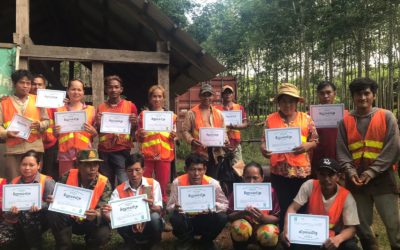Cambodia
17.2
Million inhabitants
18 103 500 ha
Country’s area
Cambodia
At the beginning of the century, Cambodia became well known among planters for the red color of its soil. Later, with the development of rubber plantations, it quickly received the name “rubber country”, a raw material also known as “white gold”.
After decades of isolation and devastation because of the civil war, the nation was reunited under the monarchy in 1993. Cambodia then experienced unprecedented economic development and recorded the fastest economic growth in Southeast Asia. This was mainly due to the textile industry, tourism and international aid. At the same time, the country specialized in fishing, forestry and agriculture, a sector that still employs nearly 35% of the workforce today.
- Rubber
Despite the conflicts, rubber cultivation has remained highly significant through the decades. Cambodia exported 530 000 tons of rubber in 2023.
In recent years, the rubber industry’s economic drive has slightly lost momentum due to a decrease in global prices. Nevertheless, exports have shown steady growth for two reasons:
- Vast areas have been planted in recent years;
- The trees have matured over the years.
As an important catalyst for development in remote areas, rubber cultivation enables the production of pure green energy: natural rubber is a substitute for synthetic rubber (a petroleum distillation product) and serves as a significant carbon sink.
THE BUNONG INDIGENOUS PEOPLE
97.6% of the population in Cambodia is Khmer. The rest is composed of different indigenous groups among which the Bunongs mainly present in the province of Mondulkiri.
Their culture is rich in myths, songs, stories and traditions related to nature and is transmitted orally. The Bunongs traditionally have a close connection with their natural environment for the collection of their food and other non-food products. They practice slash and burn agriculture.
The main threat to their culture is probably the domination of Khmer culture, which may eventually lead to complete acculturation.
Population of Bousra commune – Mondulkiri province.
Mondulkiri is the largest and least populated province in Cambodia. The commune of Bousra, where the Group is located, has 7 traditional Bunong villages (1,500 families). However, it is not easy to obtain official data on the proportion of Bunong families in this population.
Socfin-KCD and Coviphama wish to play a key role in the protection and promotion of Bunong culture as well as in the improvement of dialogue between the community and the various local actors.
From the beginning of the Group’s activities in Cambodia, a Bunong administration was set up to facilitate dialogue and ensure the continuity of traditions.
The cultural identity of the Bunongs is based in particular on the preservation of their sacred forests and cemeteries. These places are spread throughout the concessions and several measures have been taken to identify and preserve these culturally important sites (cooperation between the company’s Bunong administration and local representatives).
Today, the plantation protects more than 350 hectares of land for these sacred places.
Latest news
Students from the Faculty of Rubber science of the Royal University of Agriculture visited Socfin Cambodia
This 5th of July, we had the honor to welcome 83 students and 7 lecturers from the Faculty of Rubber science of the Royal University of Agriculture in our rubber factory! The purpose of their visit was to understand the production process of various products such as...
New graduates at Socfin Cambodia’s tapping school
Congratulations to the latest graduates from Socfin Cambodia’s tapping school in the plantation of Coviphama! After successfully completing their one-month training they will join their new colleagues from the tapping teams on the field. Do you also want to join our...
Socfin Cambodia donates essential medical supplies to help combat COVID-19
Socfin Cambodia recently donated medical furniture to the Mondulkiri provincial Publich Health Department to help improve coronavirus response in Cambodia. During the meeting, Socfin Cambodia received communications material developed by the Ministry of Health to help...


